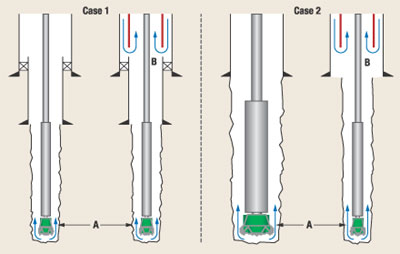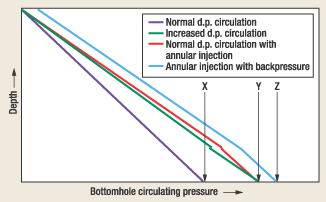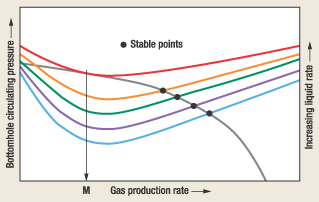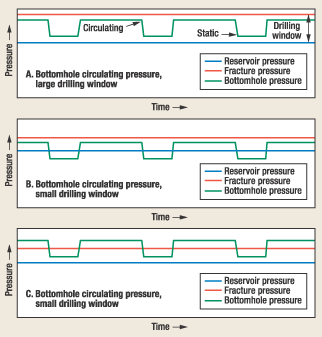Controlling pressure when drilling in high-pressure reservoirs
WELL CONTROL / INTERVENTIONControlling pressure when drilling in high-pressure reservoirsHow a new technique – dynamic pressure control – eliminates the need for high surface pressures or modification of drilling-fluid density when drilling high-pressure wells underbalancedRobert A. Graham and Peter J. C. Schermer, Deutag Northland Underbalanced Drilling Services, Great Yarmouth, UK
High-pressure reservoirs are traditionally drilled with large overbalanced margins to minimize the risk of unplanned reservoir inflow. The high pressures associated with these influxes can result in larger kick volumes, reduced reaction time and consequently, greater risk. Challenges associated with these overbalanced margins serve to increase loss of circulation risk, resulting in high-pressure kicks, differential sticking and wellbore damage. Traditional UBD equipment is increasingly used to provide kick-control for drilling applications where high-pressure zones may be encountered. However, the ability to exert control over BHP by using the low-head drilling technique is limited to wellhead pressure control. The use of high pressures at surface increases the risk of equipment failure and tubular collapse or burst. A new technique for dynamic well control addresses the need to control BHP quickly and accurately, without the need for high surface pressures or modification of drilling-fluid density. This technique involves injecting drilling fluid through a secondary annulus with the intent of controlling friction pressure. This permits swift control over a wide range of BHPs. This article discusses the major well-control objectives and well-control parameters. The primary focus will be on BHP control and how the dynamic solution compares with more traditional techniques. Finally, kick handling and the potential use of this dynamic technique in underbalanced drilling applications will be discussed. Well Control Objectives In 1989, Shell Expro discussed the control aspects of drilling high-pressure wells,1 and identified the following objectives as "a more integrated approach to high-pressure well control:"
This review was initiated as a result of restrictions on high-pressure drilling imposed by the UK Department of Energy, following a blowout and fire on the Ocean Odyssey in September 1988. A follow-up paper on "High-pressure well design" defined the worst-case scenario as "the complete wellbore evacuated to reservoir gas with a maximum expected wellhead pressure equal to the maximum expected BHP minus the hydrostatic head of the gas column."2 Well Control Parameters BHP is the sum of three components: PBH = PHyd + PFric + PWH Where: PBH = bottomhole pressure; PHyd = hydrostatic pressure; PFric = frictional pressure; and PWH = wellhead pressure. In conventional drilling operations, it is normally not possible to control the pressure at surface. The well returns flow into an open flowline at zero pressure. To achieve wellhead pressure control, well returns need to be routed through a closed flowline and a choke manifold, as in underbalanced drilling. The advantage of controlling BHP using wellhead pressure is that a pressure change at surface results in a quick pressure change at TD, when single-phase drilling fluid is used. However, it is good practice to keep surface pressure as low as possible to create a safe-as-possible working environment for rig personnel.3 Therefore, it is preferable to control the well via wellbore pressures whenever possible. This can be done by means of hydrostatic-pressure or friction-pressure control. Hydrostatic-pressure control is the prime means of BHP control in conventional drilling. The mud weight ensures an overbalanced condition when the well is static. Varying mud weight to suit reservoir conditions requires considerable time. Based on Shell’s experience in Brunei, weight changes should be made gradually to safely achieve the desired BHP.4 It is also recommended to pull back to the shoe prior to changing mud weight to prevent getting differentially stuck, which is also a time-consuming activity. The other means of BHP control is friction-pressure control. Higher circulating rates increase friction pressure and, therefore, bottomhole pressure. Friction-pressure loss combines the advantages of wellhead-pressure and hydrostatic-pressure control. A change in pump rate will result in a rapid change in BHP, allowing well control within the wellbore and not at surface. A disadvantage of this method is that control is lost when mud pumps are stopped, such as when a connection is made or when tripping out of hole. Frictional-pressure loss is also limited by the maximum pump rate, pump pressure rating and maximum flow through the downhole motor. The dynamic pressure-control method will mitigate these challenges. A Dynamic Approach The unique aspects of dynamic control of bottomhole circulating pressure are:
Cases 1 and 2, as shown in Fig. 1, illustrate two simplified configurations where this technique could be applied. Vertical wells are shown for simplicity; however, the technique would apply as effectively to directional or horizontal wells. Case 1 shows a conventional configuration with 6-in. hole drilled out of a 7-in. liner. The dynamic control case adds a 7-in. tieback to surface to provide an annular conduit for liquid injection, which should be designed for continuous circulation. In Case 2, a conventional setup would be a drilled with an 8-1/2-in. drillbit, while the dynamic-control scenario shows a smaller openhole section and a 7-in. liner run to surface to provide the annular conduit for the secondary-injection point.
For both cases, drilling system design must incorporate the following parameters:
Using the configuration in Case 1, Fig. 1, normal drillpipe circulation for adequate drilling hydraulics and hole cleaning can be assumed at point A. Assuming that bottomhole-circulating pressure (BHCP) is below the desired value, increasing circulation at point A – if the design parameters listed above permit – may increase this pressure. However, an alternative to increasing circulation at point A is adding annular liquid injection at point B. Fig. 2 shows that BHCP can, therefore, be controlled anywhere from X to Y, without changing the circulation rate at point A. In the event of a change in circulation at point A (such as interruption during a connection), the circulation rate at point B can be modified to maintain the desired BHCP. Additional pressure control can be made through increasing surface annular backpressure (BHCP Z, Fig. 2), taking care not to exceed tubular burst / collapse ratings or increasing the risk of wellhead / BOP failure.
Fig. 3 illustrates what happens when a gas kick is taken. Assuming liquid circulation rates and surface annular backpressure stay the same, once gas is introduced into the annulus, the gas influx rate will continue to increase according to the inflow-performance relationship (IPR – a reservoir dependent characteristic) until a "stable point" is reached. These stable points are discovered by overlaying the inflow performance relationship and the "friction" curves developed for increasing liquid circulation rates. Although the IPR curve may intersect the "friction" curve at two points, it is only the rightmost point – where BHCP increases with increasing gas production – that is stable. This is called the "friction dominated" portion of the curve.
By increasing the liquid injection rate, the "stable" gas production rate can be decreased until a tangent point is reached (point M in Fig. 3). Above this liquid injection rate, gas production from the reservoir will cease and only the annulus gas volume requires circulating out. As this simplified example shows, well control can be achieved by increasing the liquid injection rate when a gas "kick" is taken. However, it is quite likely that the liquid injection rate will need to be decreased once gas influx from the reservoir has ceased. This will prevent significant overbalancing that may result in circulation loss and stimulate another gas "kick". Although this example applies to gas reservoirs, the same principles can also apply to oil / condensate reservoirs. However, the impact is more easily seen in the gas case, due to the much greater difference in density between the circulating and influx media. The technique discussed above is a unique application of UBD-technology principles applied to over-pressured formations. Using these dynamic pressure-control techniques can result in safer and more-effective drilling. Pressure Control Applications Two different cases are used to describe advantages of the dynamic pressure-control method, compared to conventional well control. Case 1: Single-phase wellbore fluid. The dynamic pressure-control method is very suitable for high-pressure reservoirs, which are drilled "low-head." When drilling high-pressure reservoirs, it is important to drill with a BHP relatively close to reservoir pressure, because the drilling window, i.e., the margin between reservoir and fracture pressures, can be very narrow.4,5,6 In practice, this means that several operational considerations need to be evaluated when drilling high-pressure reservoirs "low-head." BHP adjustments. Reservoir pressure may be different than predicted. Therefore, it is important that BHP be quickly adjustable. The dynamic pressure-control method allows this by simply changing the pump rate in the concentric annulus. BHP decreases during connections due to suspension of circulation. To avoid an underbalanced condition, a heavier mud weight could be used; however, this could lead to exceeding the fracture pressure during periods of circulation or when "breaking" circulation. In Fig. 4A, the "drilling window" is larger than the difference between static BHP and circulating BHP (a.k.a. "equivalent circulating density," or ECD). This means that the well will always be overbalanced without exceeding fracture pressure. In cases Fig. 4B and Fig. 4C, the drilling window is smaller than the difference between static and circulating BHP. As a result, the well will be underbalanced during connections (4B), or the fracture pressure will be exceeded during circulation periods (4C). With the dynamic pressure-control method, circulation continues during connections, and the BHP can be kept reasonably constant.
Kick control. In high-pressure reservoirs this is more complicated than kick-control in conventional reservoirs for two reasons: 1) BHP needs to be closer to reservoir pressure to prevent exceeding the fracture pressure; and 2) the occurrence of "loss and gain" phenomena due to wellbore ballooning and thermal fracturing.5,6,7 Consequently, when drilling high-pressure reservoirs, it is more likely that a kick will be taken than when drilling conventional reservoirs. However, the dynamic pressure-control method – in combination with UBD surface separation equipment and EM-MWD technology – makes it possible to circulate out kicks faster with lower surface pressures and with more accurate BHP control. When a kick is circulated out conventionally, surface pressure will increase as the gas kick comes closer to surface and expands. When dynamic-pressure control is used, liquid is continuously pumped into the wellbore, which causes an increase in hydrostatic and friction pressure, and therefore, reduced surface pressures are required. Besides high wellhead pressures, another concern in circulating out kicks is hydrate formation. With the dynamic pressure-control method, hydrate formation is less likely to occur for two reasons: 1) the wellhead pressure is lower and therefore, 2) pressure-drops across the choke are smaller. Liquid is continuously pumped into the kick and a two-phase, gas-liquid kick is circulated out of the well instead of a single-phase gas kick. The significant volume of the liquid phase and its greater heat capacity will minimize temperature drop across the choke. Another advantage of the dynamic pressure-control method in secondary well-control events is that it serves as backup for drillstring injection. There is a possibility that ability to circulate down the drillstring could be lost (e.g., a plugged bit nozzle). In that event, the kick could still be circulated out without the need for alternative well control methods such as bullheading. Mud weight reduction. Muds with added weighting material or heavy brines are types that can be used in high-pressure reservoir drilling. Mud with added weighting material is not typically recommended when high-pressure reservoirs are drilled and well returns flow through separation equipment. The weighting material will typically separate out in the surface separation equipment preferentially to drilled solids. This makes it difficult to maintain control over mud weight and solids loading. Moreover, the weighting material can be abrasive, which causes significant surface- and downhole-equipment wear.4,8 These weighting materials can also contribute significantly to formation damage.9,10 Alternatives to the more conventional weighted mud systems are high-density brines.9,10,11,12 A solids-free fluid has more predictable rheology; using it, where possible, can simplify challenges associated with changes in frictional-pressure losses as a function of flow regime. An example of this is seen with the effect of drillstring rotation on flow regime and accompanying annular pressure loss.13 A disadvantage of brine-based drilling fluids can be their high cost. The dynamic pressure-control method increases frictional-pressure loss and consequently, hydrostatic-gradient requirements are lowered. This will significantly reduce the cost of the high-gradient drilling fluid. However, it should be noted that static kill-weight mud might still be required for tripping or well-kill operations. Case 2: Multi-phase wellbore fluid. The dynamic pressure-control method can also be used for high-pressure gas wells that are drilled underbalanced. Two operational considerations, which apply to low-head drilling in high-pressure reservoirs, also apply to underbalanced drilling of high-pressure gas reservoirs: 1) the ability to make fast BHP adjustments; and 2) the necessity to have accurate BHP control during connections. When a connection is made in underbalanced drilling, wellhead pressure can be increased to compensate for frictional-pressure loss. During connection, no liquid is pumped into the wellbore through the drillstring, but liquid will continue to be displaced from the well. Increasing wellhead pressure compensates for this loss in hydrostatic pressure due to unloading of liquid from the wellbore. However, the advantage of the dynamic pressure-control method is that even during a connection, liquid can be pumped into the wellbore, which prevents unloading of the well. This results in more constant BHP, since the gas-liquid ratio can be maintained. When using the dynamic pressure-control method to drill underbalanced in a high-pressure gas reservoir, it is advisable to design the secondary annular-injection system such that the pressure capable of being generated at the secondary annular-injection point is equal to or greater than reservoir pressure. This ensures that the well can be killed without having to pump down the drillstring. The rationale for this is due to the often-unknown inflow performance relationship of the reservoir and the minimum gas influx, shown as point M, Fig. 3. Should this point exceed surface gas-handling constraints, well control can be maintained without invoking emergency well-control procedures. In this event, low-head drilling operations could commence. Engineering Issues There are some engineering issues that have to be taken into consideration when using the dynamic pressure-control method. When using friction pressure loss to control the well, reliance is placed on the ability to pump liquid through the concentric annulus to keep the well overbalanced. Should the pump break down, friction pressure would be lost and a kick could be taken. Therefore, it is recommended to use the dynamic pressure-control method in combination with UBD surface separation equipment to ensure that gas kicks can be circulated out quickly and safely. The dynamic pressure-control method can be used for various BHP-control applications. However, it is not a tool to determine true BHP – an important quantity. Real-time BHP-measurement technology is preferable due to its ability to solicit downhole-pressure data on demand and continuously acquire downhole pressure data without circulating down the drillstring. Consideration of borehole stability can be vital to successful drilling in high-pressure formations.14 One cause for borehole collapse is cycling of BHP, which causes alternating formation stresses near the borehole. Using the dynamic-pressure-control method helps maintain a more constant BHP and, therefore, reduces cyclic stressing of the wellbore. Both pressure windows and chemical compatibility issues should also be addressed when determining risks associated with drilling in such formations. Success of the dynamic pressure-control method relies on the ability to create friction in the wellbore at any point during drilling operations. When tripping out, pipe is removed from the hole and it becomes increasingly difficult or impossible to create sufficient frictional-pressure loss in the wellbore. Therefore, it is necessary to develop clear tripping strategies and procedures to ensure that well control is maintained. Conclusions The dynamic pressure-control method is a novel approach using UBD techniques to enhance safety and well control when drilling high-pressure reservoirs. The slim operating window between pore pressure and fracture pressure is more easily navigated through the use of this technique, especially when used in conjunction with real-time BHP measurement and UBD surface equipment. The use of the secondary annular-injection point provides a method to circulate out kicks more easily and safely, and at lower surface pressures. Using dynamic-pressure control does not preclude the need to perform detailed feasibility studies and evaluate thermal regimes, borehole stability and fluid compatibility issues, etc. Dynamic-pressure control in conjunction with real-time BHP measurement reduces many challenges associated with the loss and gain phenomenon by offering more-constant control over BHP, whether drilling or making connections. Hole cleaning is enhanced through ability to maintain circulation above the secondary, annular-injection point, thus minimizing some of the cuttings settling that can occur during circulation interruptions through the drillstring. Using clear brine fluids in conjunction with the dynamic pressure-control technique optimizes drilling performance by simplifying flow regimes and solids-control issues. Formation damage is minimized through this combination of more steady-state BHCP and reduced solids exposure. Drilling high-pressure wells underbalanced is more feasible using dynamic pressure control in conjunction with suitable UBD surface equipment. Acknowledgment The authors thank Northland Energy Corp. and Deutag UK Ltd. for the opportunity to present this article. This article was adapted from a presentation at the 2001 IADC Underbalanced Technology Conference & Exhibition held in Aberdeen, Scotland, November 27 – 28, 2001. Literature Cited 1 Prieur, J. M., "Control aspects of drilling high-pressure wells," SPE 19245. 2 Krus, H. and J. M. Prieur, "High-pressure well design," SPE 20900. 3 Rehm, B., "How to control surface and bottomhole pressures during UBD", World Oil, March 2001. 4 Williams, M. J. and P. Dumont, "A review of HPHT drilling campaign, 1991 – 1995," IADC/SPE 36403. 5 Santarelli, F. J., C. Dardeau and C. Zurdo, "Feasibility study for a horizontal well in a high pressure and temperature environment", SPE 25051. 6 V. Maury and J. L. Idelovici, "Safe drilling of hp/ht wells, the role of the thermal regime in loss and gain phenomenon," SPE/IADC 29428. 7 Gill, J. A., "How borehole ballooning alters drilling responses", Oil & Gas Journal, Vol. 87, No. 11, pp._43 – 46, 48, 52. 8 Robinson, L. H. and J. K. Heilhecker, "Solids control in weighted drilling fluids," JPT, September 1975, pp._1141 – 1143. 9 Swartwout, R., R. Pearcy, "Design and application of brine-based drilling fluids," SPE 35332. 10 Ramsey, M. S., et al., "Cesium formate: results and analysis of drilling with a new high density unweighted brine," SPE 36425. 11 Downs, J. D., et al., "Development of environmentally benign formate-based drilling and completion fluids," SPE 27143. 12 J. H. Hallman, "Formates in practice: Field use and reclamation," World Oil, October 1996, pp. 81 – 90. 13 Marken, C. D., Xiaojun He and A. Saasen, "The influence of drilling conditions on annular pressure losses,", SPE 24598 14 Van Oort E., J. Nicholson and J. D’Agostino, "Integrated borehole stability studies: key to drilling at the technical limit and trouble cost reduction," SPE/IADC 67763.
|
|||||||||||||||||||||
- Coiled tubing drilling’s role in the energy transition (March 2024)
- Using data to create new completion efficiencies (February 2024)
- Digital tool kit enhances real-time decision-making to improve drilling efficiency and performance (February 2024)
- E&P outside the U.S. maintains a disciplined pace (February 2024)
- U.S. operators reduce activity as crude prices plunge (February 2024)
- Drilling advances (January 2024)
- Applying ultra-deep LWD resistivity technology successfully in a SAGD operation (May 2019)
- Adoption of wireless intelligent completions advances (May 2019)
- Majors double down as takeaway crunch eases (April 2019)
- What’s new in well logging and formation evaluation (April 2019)
- Qualification of a 20,000-psi subsea BOP: A collaborative approach (February 2019)
- ConocoPhillips’ Greg Leveille sees rapid trajectory of technical advancement continuing (February 2019)








